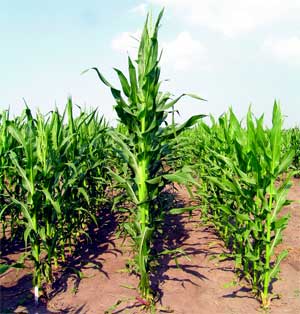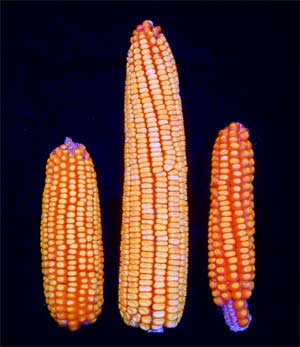Ames, Iowa
May 8, 2006
For nearly 80 years, corn breeders
and producers have taken advantage of hybrid vigor to grow
high-yielding crops. Yet this biological process remains a
scientific mystery. No one really understands why crossing
specific lines of corn that are genetically quite different can
produce a hybrid that outperforms both parent lines.
That could change, however, thanks to ongoing research in
Iowa State University's
Plant Sciences Institute. Researchers have uncovered a key to
understanding the complex molecular mechanisms of hybrid vigor,
also known as heterosis, which affects most aspects of plant
growth and development. Once the gene activity behind hybrid
vigor is well understood, scientists could more rapidly create
hybrids that confer desired traits like ethanol production into
the germplasm.
The research team, led by Patrick Schnable, professor of
agronomy and director of the Center for Plant Genomics, includes
Dan Nettleton, associate professor of statistics; and graduate
students Ruth Swanson-Wagner, Yi Jia, Rhonda DeCook and Lisa
Borsuk.
Their research is published in the May 2 issue of the scientific
journal, Proceedings of the National Academy of Science ("All
Possible Modes of Gene Action are Observed in a Global
Comparison of Gene Expression in a Maize F1 Hybrid and Its
Parents").
 |
|
B73
(left), the F1 hybrid (center), Mo17 (right) |
 |
For the two-year experiment, the researchers used the maize F1
hybrid and its inbred parents corn lines, B73 and Mo17. The F1
is taller, matures more quickly and produces higher grain yields
than both parents.
"We analyzed global patterns of gene expression in these three
genotypes because this hybrid and its relatives are widely grown
in the Corn Belt," Schnable said. "Also, the genetic map of corn
is based on recombinant inbreds developed from this hybrid."
The researchers grew seedlings of the three genotypes in growth
chambers to tightly control environmental effects. They isolated
RNA from each of the three genotypes, and used a maize gene chip
to determine the amount of RNA that accumulates for each gene in
each of the three genotypes.
"We used this gene expression information to understand how each
of thousands of genes behave in the genetic background, "
Schnable said.
Using microarray technology, the researchers observed the
activity of nearly 14,000 genes at the same time. The technology
enabled them to look simultaneously at the gene expression of
the hybrid and its inbred parents. This is the first study that
has looked at hybrid vigor in any crop on such a large scale.
They found that some genes are more active in the hybrid than in
both of the parental inbred lines (overdominant), some genes are
less active than both inbred lines (underdominant) and most
genes —78 percent — have activity levels in between the level of
the inbreds (additive).
"Several molecular models have been proposed to explain the
phenomena of hybrid vigor. Some models require that genes
exhibit overdominance or underdominance. Others assume that
overdominant and underdominant gene expression is not an
important contributor to hybrid vigor," Schnable said.
The results of the Iowa State experiment provide support for
multiple mechanistic explanations for hybrid vigor.
"Although this research does not explain hybrid vigor, it begins
to uncover what happens on a molecular level in a hybrid
compared to the inbred parents. It shows us that there are
multiple molecular mechanisms at work and that hybrid vigor is
complex," Schnable said.
"To understand this important biological process, we will need
to apply cutting-edge, high-throughput genomic technologies. The
Plant Sciences Institute at Iowa State is one of very few
public-sector organizations in the world that has the technology
and resources necessary to conduct this research," he said.
The research findings provide a foundation for the Iowa State
scientists to explore specific genes of interest, or investigate
the contributions of the different mechanisms resulting in the
gene expression patterns found. Their next step is to determine
the genetic control of overdominance.
"Ultimately, it is likely that we would be able to predict which
specific inbreds when crossed would produce a strong heterotic
response. To a large extent, this is now a matter of trial and
error. Consequently, we might be able to develop favorable
hybrids more quickly for less cost. This would result in faster
genetic gain," Schnable said.
The research was funded by the state of Iowa, Iowa State
University's Plant Sciences Institute and the Iowa Agriculture
and Home Economics Experiment Station. |